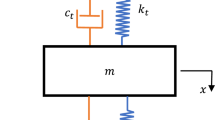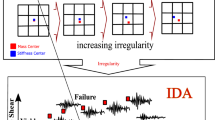Abstract
Adding dampers is a commonly adopted seismic risk mitigation strategy for modern buildings, and the corresponding design procedure of dampers has been well established by the Chinese Building Code. Even though all types of dampers are designed by the same procedure, actual seismic performance of the building may differ from one to the others. In this study, a nine-story benchmark steel building is established, and three different and typical types of dampers are designed according to the Chinese Building Code to realize structural vibration control under strong earthquake excitation. The seismic response of the prototype building equipped with a viscoelastic damper, viscous damper and buckling-restrained brace (BRB) subjected to 10 earthquake records are calculated, and Incremental Dynamic Analysis (IDA) is performed to describe progressive damage of the structure under increasing earthquake intensity. In the perspective of fragility, it shows that the viscoelastic damper has the highest collapse margin ratio (CMR), and the viscous damper provides the best drift control. Both the BRB and viscoelastic dampers can effectively reduce the floor acceleration responses in the mid-rise building.
Similar content being viewed by others
References
ASCE-7-10, Minimum Design Loads for Buildings and Other Structures, American Society of Civil Engineering.
ASCE (2013), Seismic Evaluation and Retrofit of Existing Buildings, American Society of Civil Engineering.
Chang Kuo-Chun, Lin Yu-Yuan and Chen Chang-Yu (2008), “Shaking Table Study on Displacement-Based Design for Seismic Retrofit of Existing Buildings Using Nonlinear Viscous Dampers,” Journal of Structural Engineering, 134(4): 671–681.
Chiou Brian, Darragh Robert, Gregor Nick, et al. (2008), “NGA Project Strong-Motion Database,” Earthquake Spectra, 24(1): 23–44.
FEMA 451, NEHRP Recommended Provision, Federal Emergency Management Agency.
FEMA-P695 (2009), Quantification of Building Seismic Performance Factors, US Department of Homeland Security, FEMA.
Fu Yaomin and Kasai Kazuhiko (1998), “Comparative Study of Frames Using Viscoelastic and Viscous Dampers,” Journal of Structural Engineering, 124(5): 513–522.
GB50010-2010, Code for Seismic Design of Buildings, China Architecture & Building Press, Beijing. (in Chinese)
Gu Quan, Liu Yongdou, Guo Wei, et al. (2018), “A Practical Wheel-Rail Interaction Element for Modeling Vehicle-Track-Bridge Systems,” International Journal of Structural Stability and Dynamics: 1950011.
Guo Wei, Li Hong-nan and Guo Zhen (2010), “Perturbation Spectrum Method for Seismic Analysis of Non-Classically Damped Systems,” Journal of Zhejiang University-SCIENCE A, 11(5): 325–334.
Guo Wei, Yu Zhi-Wu and Guo Zhen (2011), “Fast Stochastic Analysis for Non-Proportionally Damped System,” Mechanics Research Communications, 38(6): 468–470.
Guo Wei, Li Hong-nan, Liu Guo-huan, et al. (2012), “A Simplified Optimization Strategy for Nonlinear Tuned Mass Damper in Structural Vibration Control,” Asian Journal of Control, 14(4): 1059–1069.
Guo Wei, Yu Zhi-wu and Guo Zhen (2013), “An Efficient and Accurate Method for Calculating Stochastic Seismic Response of Non-Proportionally Damped Structure,” Journal of Structural Engineering, 139(3): 472–477.
Guo Wei, Yu Zhi-wu, Liu Guo-huan, et al. (2013), “Possible Existing Seismic Analysis Errors of Long Span Structures and Bridges while Utilizing Multi-Point Earthquake Calculation Models,” Bulletin of Earthquake Engineering, 11(5): 1683–1710.
Hou Wenqi, Li Yankun, Guo Wei, et al. (2018), “Railway Vehicle Induced Vibration Energy Harvesting and Saving of Rail Transit Segmental Prefabricated and Assembling Bridges,” Journal of Cleaner Production, 182: 946–959.
JGJ297-2013, “Technical Specification for Seismic Energy Dissipation of Building,” China Architecture & Building Press, Beijing. (in Chinese)
Kasai K, Ito H, Motoyui S, et al. (2009), “Full-Scale Tests on Value-Added Performance of 5-Story Building with Various Dampers Commercially Available,” in 7th CUEE and 5th ICEE Joint Conference, Tokyo Institute of Technology, 3–5 March 2010, Tokyo, Japan.
Kelly James M, Skinner RI and Heine AJ (1972), “Mechanisms of Energy Absorption in Special Devices for Use in Earthquake Resistant Structures,” Bulletin of NZ Society for Earthquake Engineering, 5(3): 63–88.
Li Gang and Li Hongnan (2004), “Experimental Study on Improved Mild Metallic Dampers,” Proceedings of the Third China-Japan-US Symposium on Structural Health Moni-toring and Control and Fourth Chinese National Conference on structural Control.
Li Hong-Nan and Li Gang (2007), “Experimental Study of Structure with “Dual Function” Metallic Dampers,” Engineering Structures, 29(8): 1917–1928.
Liu GuoHuan, Guo Wei and Li HongNan (2010), “An Effective and Practical Method for Solving an Unnegligible Problem Inherent in the Current Calculation Model for Multi-Support Seismic Analysis of Structures,” Science China Technological Sciences, 53(7): 1774–1784.
Ohtori Y, Christenson RE, Spencer Jr BF, et al. (2004), “Benchmark Control Problems for Seismically Excited Nonlinear Buildings,” Journal of Engineering Mechanics, 130(4): 366–385.
SEAOC Vision-2000 (1995), Performance-Based Seismic Design, California RpbSEAo, Sacramento, CA.
Sun Feifei, Li Guoqiang, Guo Xiaokang, et al. (2011), “Development of New-Type Buckling-Restrained Braces and Their Application in Aseismic Steel Frameworks,” Advances in Structural Engineering, 14(4): 717–730.
Wang Xiaolin (2005), “Seismic Reliability Analysis for Functional Utility System in Hospital,” Master’s Thesis, Beijing University of Technology. (in Chinese)
Wu Bin, Zhang Jigang, Williams MS, et al. (2005), “Hysteretic Behavior of Improved Pall-Typed Frictional Dampers,” Engineering Structures, 27(8): 1258–1267.
Xiong Mingpan (2016), “Vulnerability Analysis Of High-Voltage Electrical Equipment Based on Ground Motion Parameter,” Master’s Thesis, Institute of Engineering Mechanics, China Earthquake Administration. (in Chinese)
Yu Zhiwu, Liu Hanyun, Guo Wei, et al. (2017), “A General Spectral Difference Method for Calculating the Minimum Safety Distance to Avoid the Pounding of Adjacent Structures During Earthquakes,” Engineering Structures, 150: 646–655.
Zhao Bin, Taucer Fabio and Rossetto Tiziana (2009), “Field Investigation on the Performance of Building Structures During the 12 May 2008 Wenchuan Earthquake in China,” Engineering Structures, 31(8): 1707–1723.
Zhao Junxian, Wu Bin and Ou Jinping (2011), “A Novel Type of Angle Steel Buckling-Restrained Brace: Cyclic Behavior and Failure Mechanism,” Earthquake Engineering & Structural Dynamics, 40(10): 1083–1102.
Zhao Zuozhou, Hu Yu and Qian Jiaru (2015), “Comparison of Ground Motion Selection Between Chinese and American Methods and Elasto-Plastic Time History Analysis of Frame-Core Wall Structures,” Journal of Building Structures, 36: 10–18.
Zhou Fulin, Cui Hongchao, ABE Shigetaka, et al. (2012), “Inspection Report of the Disaster of the East Japan Earthquake by Sino-Japanese Joint Mission,” Building Structure, 4: 002.
Zhou Yun, Deng Xuesong and Xu Zhaodong (2001), “Experimental Study on Properties of Lead-Viscoelastic Dampers,” Earthquake Engineering and Engineering Vibration, 1: 025.
Acknowledgement
This work was supported by the National Natural Science Foundation of China (No. 51108466), Development Program for Changjiang scholars and innovative team (No. IRT1296) and the Project of Innovation-Driven Plan in Central South University. These supports are gratefully acknowledged.
Author information
Authors and Affiliations
Corresponding author
Rights and permissions
About this article
Cite this article
Guo, W., Wu, J., Hu, Y. et al. Seismic performance evaluation of typical dampers designed by Chinese building code. Earthq. Eng. Eng. Vib. 18, 433–446 (2019). https://doi.org/10.1007/s11803-019-0486-9
Received:
Accepted:
Published:
Issue Date:
DOI: https://doi.org/10.1007/s11803-019-0486-9




